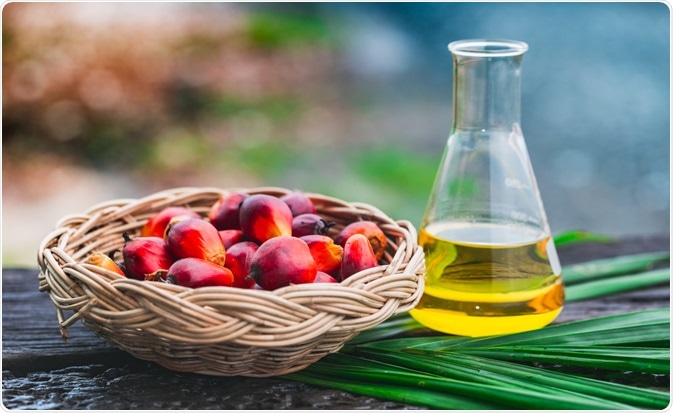Global demand for palm oil has increased rapidly over the last decade owing to its versatile properties such as its high melting point. It is widely used in the chemical, cosmetics, and food industries.
Palm oil is mostly used as vegetable oil. It is extracted from the fruits of the oil palm tree (Elaeis guineensis). This article discusses the different aspects of palm oil, namely, its cultivation, health benefits, and how mass cultivation affects our environment.

Palm Oil. Image Credit: nirapai boonpheng/Shutterstock.com
Geographical Regions and Growing Conditions Palm Oil Tree
The palm oil tree was originally found in West Africa. However, more recently, Indonesia and Malaysia are considered the world’s largest palm oil-producing nations. Other regions that grow oil palm trees are South and Central America, and Thailand.
Oil palm trees thrive well in regions around the equator. This tree requires plenty of sun and humidity, temperatures ranging between 24-32 degrees centigrade, and rainfall evenly distributed throughout the year. Oil is generally extracted from the palm fruits of trees that are three to four years old. Researchers have estimated that a palm fruit generally contains approximately 30-35 percent oil and a year’s production of oil from one palm tree is approximately 40 kilograms.
The oil palm tree yields two types of oil:
- Oil extracted from the flesh of the fruit (palm oil)
- Oil extracted from the seed or kernel (palm kernel oil)
Uses of Palm Oil
Global production of palm oil is about 73 million tons a year, which represents around 40 percent of the overall vegetable oil production around the world. To meet the global demand for vegetable oil, World Wildlife Fund (WWF) estimated that the same amount of alternative oil (coconut or soyabean oil) production would require 10 times more land.
Palm oil is generally used in both the crude and refined form. The crude palm oil has a rich orange color as it is extracted from the orange-colored pulp of the palm fruit. This oil is used for domestic cooking in Africa, Southeast Asia, and in some parts of Brazil.
The refined palm oil is odorless and pale yellow. This form of palm oil is widely used in Europe and the United States. It is also a valuable constituent of enormous products like sauces, cakes, margarine, spreads, and pastries. It is also used in frozen pizzas and chocolate bars.
Palm oil is also used in non-food products such as body lotions, soap, candles, sun creams, detergents, cosmetics, and shampoos.
The properties of palm oil can be tailored by chemical treatment such as hydrogenation. Neste, a Finnish oil refining and marketing company, has recently obtained a patent for the hydrogenation process. It is aiming to saturate the European market with cheap palm-oil diesel. They have built three huge palm oil refineries, located in Rotterdam, Singapore, and Helsinki.
Is Palm Oil Good for Health?
In recent years, researchers have found that the unhealthiest fat is trans-fat. It not only increases LDL and triglyceride levels but also lowers "good" HDL cholesterol. Mostly trans-fat is used in fried foods and processed baked goods. As the use of trans-fat has been banned recently, food manufacturers and restaurants started using palm oil as an alternative.
Nutrition experts at Harvard have stated that palm oil is less saturated than butter and contains no trans-fat. Palm oil has a more favorable fatty acid composition and is 50% saturated, contrary to palm kernel oil which is more than 85% saturated.
The experts have also said that both palm oil and palm kernel oil contain a high concentration of saturated fat, which is linked to cardiac disease. Saturated fats increase LDL cholesterol and triglycerides, both of which act as a risk factor for heart disease.
Researchers have also reported that palm oil contains fatty acid esters (3-MCPD and glycidol fatty acid esters) that are considered carcinogenic. High levels of these fatty acid esters are found in refined palm oil. The German Federal Institute for Risk Assessment has issued a warning against consuming food items containing palm oil.
How Do Palm Trees Farming Affect Our Environment?
The extensive cultivation of oil palm trees is regarded as a major threat to the environment because it promotes a high rate of deforestation. Around 8% of the world’s deforestation that has happened between 1990 and 2008 is due to palm oil production. Recently, palm oil plantation is the main reason for rainforest demolition in Malaysia and Indonesia.
Forests are burned down to acquire more land to grow oil palm trees, which would be highly beneficial economically. However, this brutally destroys biodiversity. The forest is home to many endangered plants and wildlife. The numbers of many species of animals, such as orangutans, rhinos, elephants, and tigers have been reduced due to massive deforestations. Orangutans are particularly vulnerable owing to their dependence on large contiguous forest areas.
Scientists have reported that major greenhouse gas emission is associated with the process of preparation of rainforest land for palm oil plantation. Tropical deforestation is responsible for about 18 percent of greenhouse gas emissions, which play a pivotal role in climate change.
What is Palm Oil? - BBC
Conclusion
In 2003, major palm oil producers and consumers have established a group called the Roundtable on Sustainable Palm Oil (RSPO). Members of the group are given strict rules and guidelines regarding the production of palm oil. Several companies such as Unilever, Nestlé, and Procter & Gamble, which rely on palm oil, have pledged to utilize certified palm oil exclusively.
References and Further Reading:
Further Reading
Last Updated: Sep 2, 2022